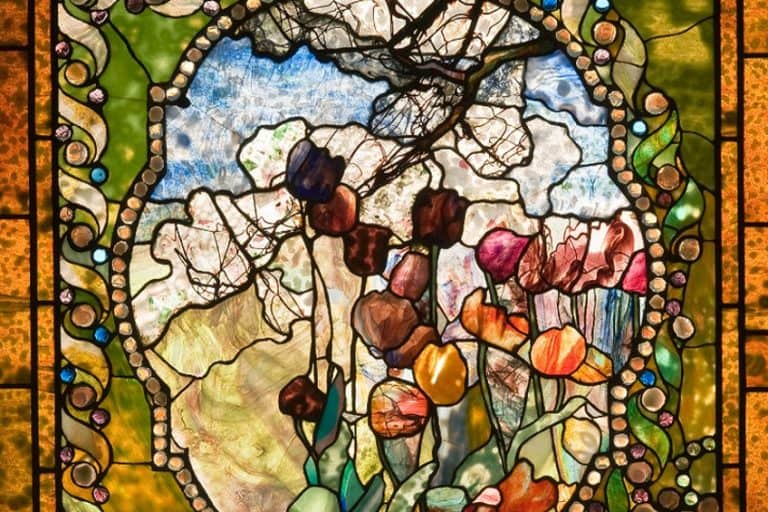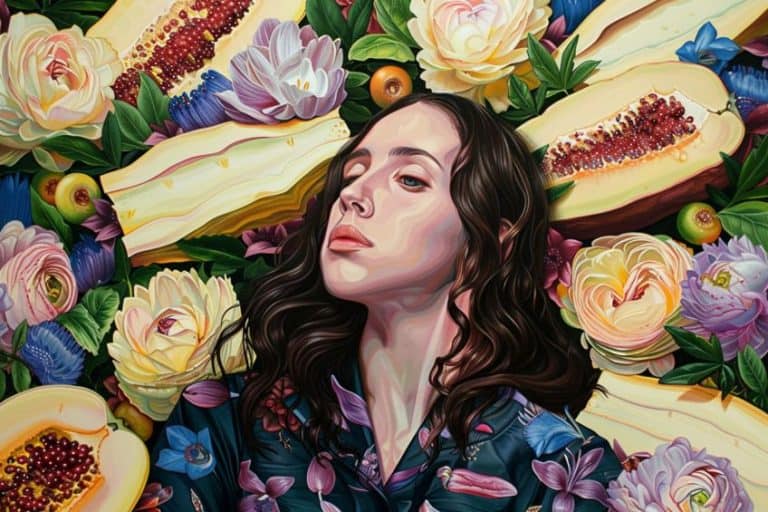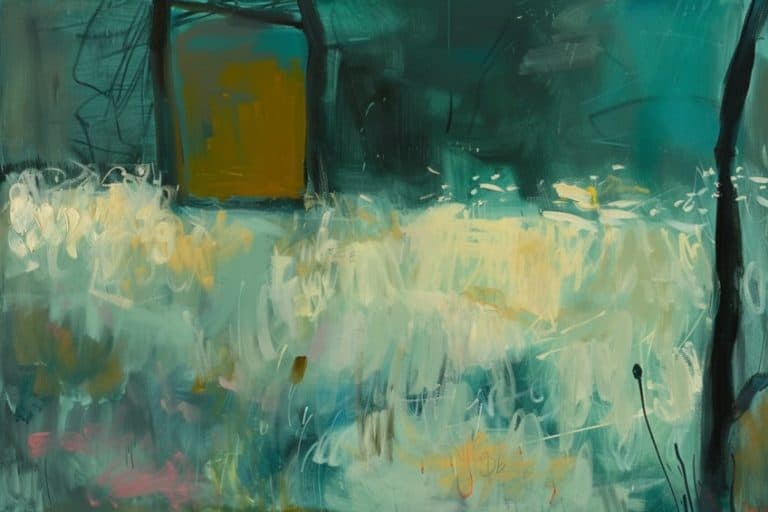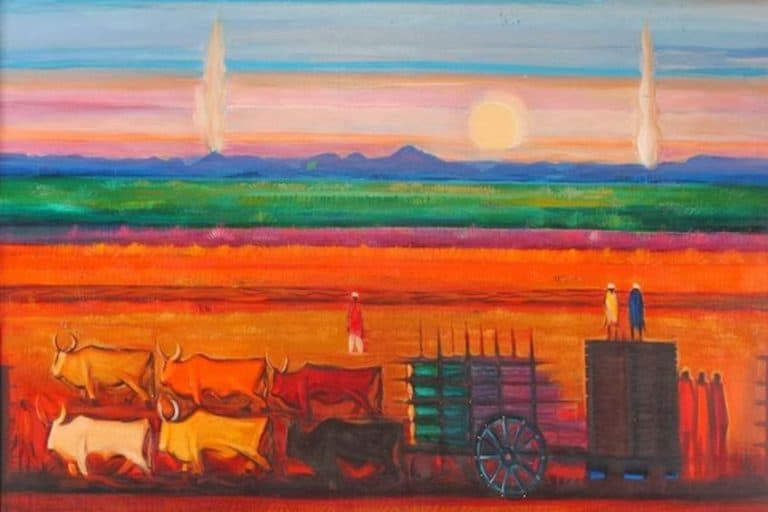Hieronymus Bosch – Medieval Art of This Master of Earthly Delights
Hieronymus Bosch the artist is most instantly identified with paintings with a shockingly intense, dream-like aspect, and he is maybe the most artistically creative and ethically complicated of all Northern European ecclesiastical artists. Though only around 25 original Hieronymus Bosch paintings are known to remain, the horrific imagery of Hieronymus Bosch’s hell paintings such as the Garden of Earthly Delights is immediately identifiable as “Boschian” and has become a mainstay of the bizarre genre. While his social standing as an iconoclast is undeniable, some historians believe he was a rather traditionalist character who, instead of having a distraught psyche, proved equally as capable of being nuanced and supplemented his horrific visuals with fine stylish and spiritual works that encapsulated his deeply held Christian beliefs.
Hieronymus Bosch’s Biography
Hieronymus Bosch was among the first painters to use the triptych as a narrative technique to express abstract notions in his works. Reviewers and scholars have discovered a variety of contemporaneous motifs in his stories, such as environmental, cultural, and sociopolitical commentary, yet perhaps his most distinguishable creations, such as his finest masterwork, The Garden of Earthly Delights (1490-1510), are also most concentrated with religious imagery and the encompassing topic of humanity’s ageless virtuous battle between recklessness and morality.
| Artist Name | Leonardo di ser Piero da Vinci |
| Date of Birth | 14 April 1452 |
| Date of Death | 2 May 1519 |
| Nationality | Italian |
| Medium | Painting |
| Associated Movements, Themes, and Styles | Early Netherlandish, Renaissance |
Childhood
Bosch was born between 1450 and 1456 (his exact birth year is unknown but has been determined based on a self-portrait dated approximately 1508) to Antonius van Aken and his wife, Aleid van der Mynnem. He was born in the opulent family of his grandpa in the wealthy and artistically and academically rich village of s-Hertogenbosch, Duchy of Brabant, situated in the lower parts of the Netherlands.
Johannes Thomaszoon van Aken, his grandfather, was one of the most significant artists in the early 15th century in s-Hertogenbosch and established a “painting family of five children,” four of whom went on to become artists, according to art expert Stefan Fischer.
Aside from the information that 4,000 dwellings in s-Hertogenbosch were devastated by a devastating fire in 1463, nothing is recorded about Bosch’s formative days. Claire Selvin, an art historian, characterized it like this: “It is thought that the artist witnessed this calamity, which was possibly one of the most traumatic moments of his childhood. It’s probable that the calamitous event impacted Bosch’s subsequent paintings, some of which include roaring fires in the backdrop “.
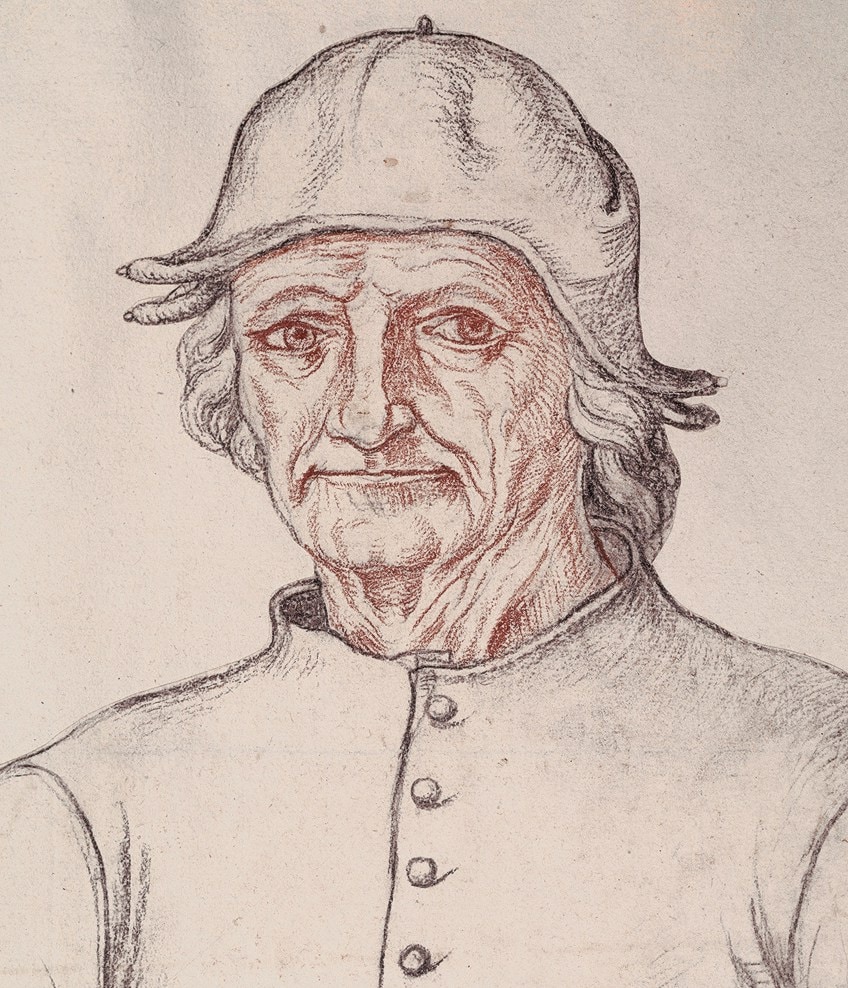
Early Training
Because he left no journals, letters, books, or other similar artifacts, nothing is known about his training. Nevertheless, in 1475 s-Hertogenbosch municipal records, Hieronymus is named as a member of his father’s studio, and it is thought that his father and probably one of his uncles instructed him to paint.
This information, however, does not get us any closer to comprehending the wellspring of Bosch’s extraordinary imagination.
Between 1480 and 1481, Bosch married Aleid van der Mervenne, the daughter of a trader. Aleid, who was a few years his senior, was the heir of a large inheritance, which included a family estate in the nearby town of Oirschot, where the couple resided. Bosch is considered to have never traveled or been outside of his close surroundings.

Salvin (through Fischer) claims that “Bosch benefited from the wealth, property, and position that came with the marriage, and he opened his own workshop shortly after the couple married. At this stage in his life, Bosch had established himself as a painter in his own capacity, and he was ready to establish substantial ties with powerful royal sponsors.”
Indeed, a mention of his name and occupation appeared in the municipal records of s-Hertogenbosch in 1486, designating him as a distinguished painter.
Because s-Hertogenbosch was under the control of the Roman Empire, it is probable that Bosch was well-versed in the Renaissance art that was inspiring the Flemish painters. Furthermore, in 1488, when he was roughly 40 years old, Bosch entered the Brotherhood of Our Lady, an orthodox Catholic organization made up of around 40 of s-Hertogenbosch’s powerful individuals, as well as 7,000 “outside members” spread across Europe.
The Brotherhood (for whom Bosch’s father had previously served as an artistic consultant) was dedicated to the Virgin and was well-known across Catholic Europe.
Some of the artist’s initial religious commissions are said to have come from the Brotherhood, however, it is unknown whether any of these pieces have survived. Fischer writes in his commentary on one of his earliest known works, Crucifixion with Saints and Donor (c. 1490), that “While its original location is unidentified, the artwork, like many other Christian images of the time, was generated to guarantee redemption for the soul of the benefactor illustrated bowing at the foot of the crucifix.
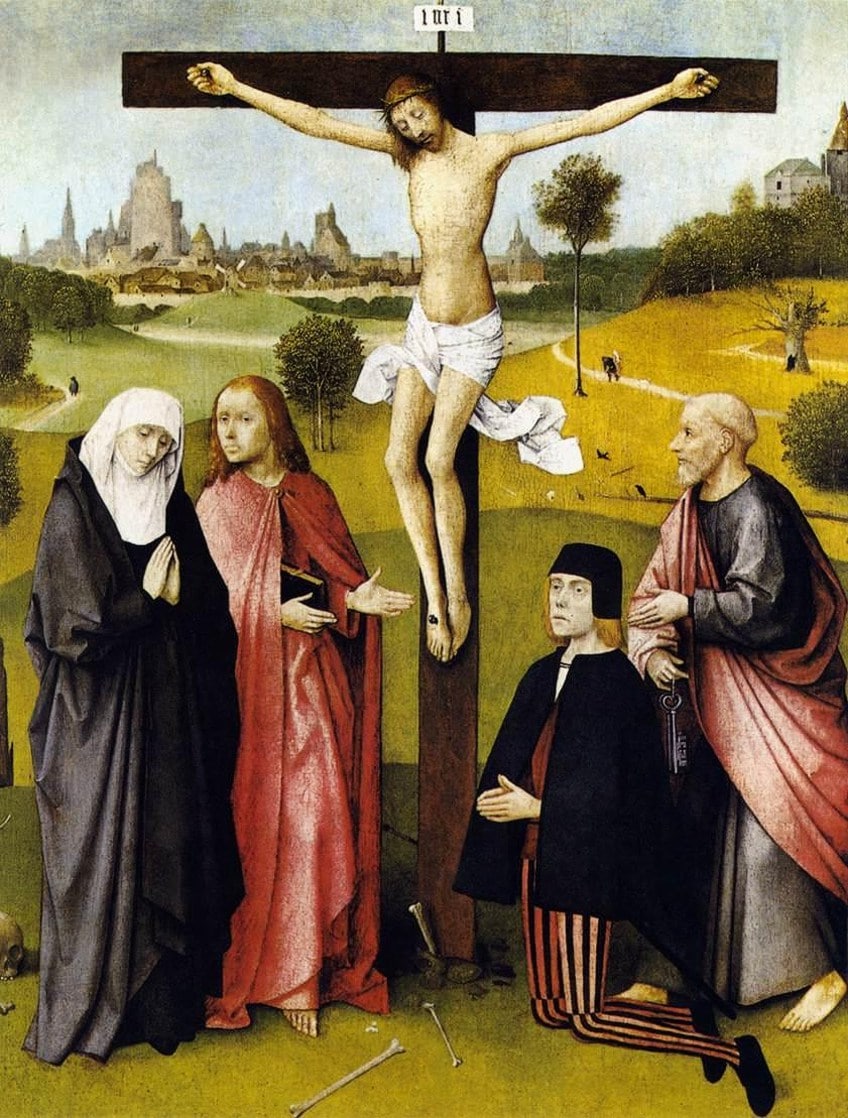
Crucifixion with Saints and Donor is an anomaly in a body of works that favors unusual, whirling, and unsettling arrangements, and Bosch would subsequently project his peculiar style onto a variety of religious topics “. However, as art experts point out, “Despite the uniqueness of his work, there is no proof that Bosch was an outcast in any way. While some highly speculative study in the 1940s sought to link him to a heretical sex cult known as the Adamites, and the 1960s counterculture had him tripping on ergotic grain, mainstream scholarly opinion paints a much kinder image. Nothing shows that Bosch was anything more than a renowned and rich citizen, an ardent Catholic, and a popular devotional painter among clients”.
Mature Period
While other painters from Northern Europe were also focused on making scriptural themes, Bosch was expressing the very same subject matter in such an unusually creative way that it completely clashed with the harmonious and dominating Flemish manner.
He transformed religious tales into astonishing new fantasy realms filled with absurd and religious symbolism by filtering them through his mind.
Bosch’s signature style – comprising deformed and distorted body forms, intense colors, huge and threatening flora, and different demons and reptiles – begins to manifest itself via a sequence of saints during his extremely loosely defined “middle period.” This can be observed in works such as St. John the Baptist in Meditation (1490), St. Jerome at Prayer (c. 1485-90), and St. John on Patmos (1490-95), an altarpiece presumably commissioned by the Brotherhood of Our Blessed Lady.
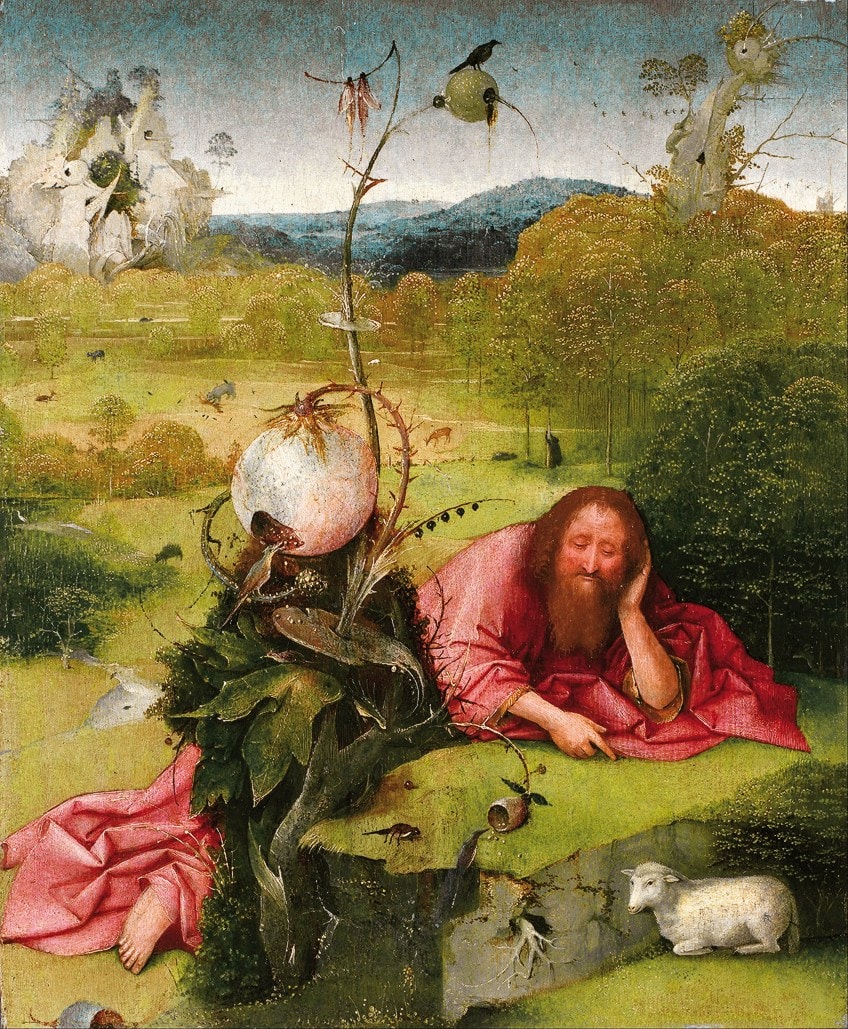
However, his Adoration of the Magi (c. 1494) is often regarded as his first great masterpiece. The painting, commissioned by Antwerp’s Agnese de Gramme and Peter Scheyfve, substantially cemented the artist’s renown, even though it did not mesh well with Bosch’s “brand awareness” in subsequent years. As Smith-Laing pointed out:
“When Bosch died in 1516, he was already one of the most well-known painters of his era, and he quickly became one of the most imitated and reproduced. By the 1530s, an entire school of artists in Antwerp had developed dedicated to just that, and it was with them that Bosch’s prophetic picture began to crystallize”.
Smith-Laing argues that when “contemporary marketing experts” became interested in Bosch’s art, they referred to him solely as “a supplier of infernal diableries,” and that “stilly meditative” pieces such as The Adoration of the Magi were widely neglected.
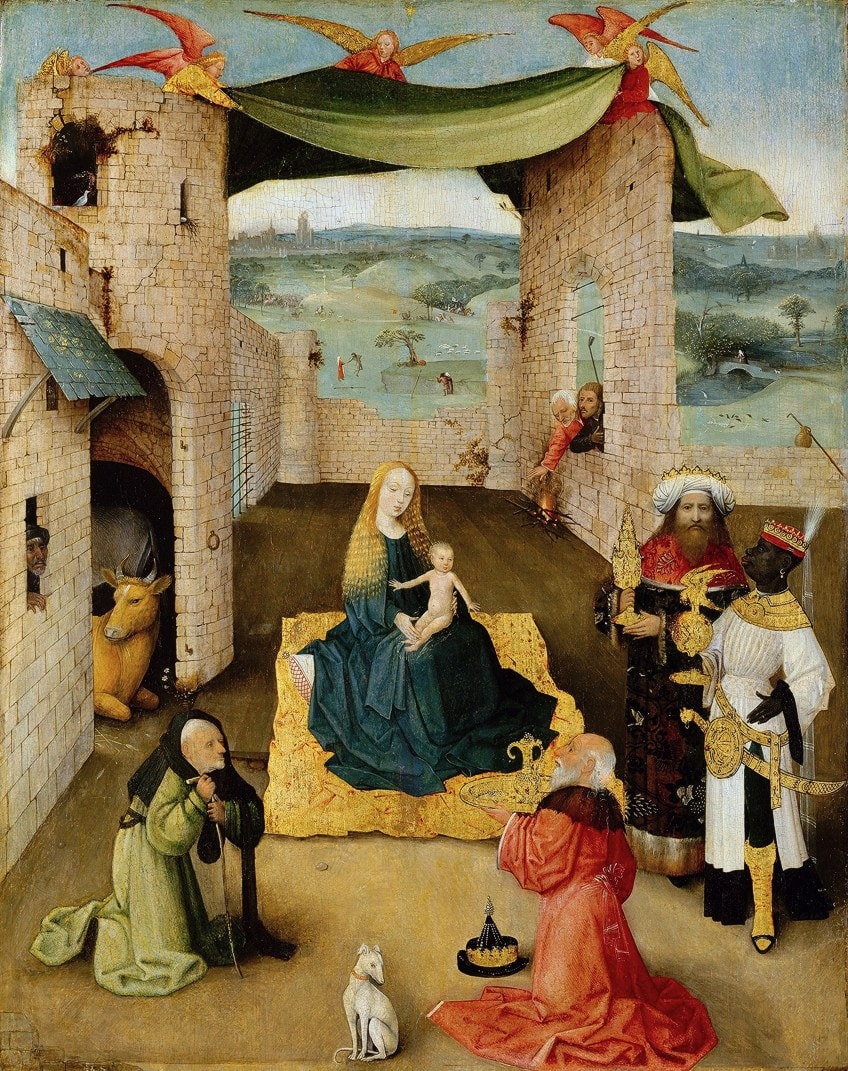
As the end of the 15th century neared, a famous German astrologer predicted that the “end of the world” would be precipitated by catastrophic floods on the 25th of February, 1524. The concept of the Last Judgement became popular, with Albrecht Dürer creating a famous watercolor capturing a vision in which he observed the last end of days (as ocean tumbling down from the sky onto the ground) and Bosch producing The Last Judgement, which covered the very same topic but with Hieronymus Bosch’s hell paintings inhabited with implausible demons, evil spirits, metamorphized lifeforms, and sexual imagery.
Dürer and Bosch (along with other geniuses, no doubt) would have sent ripples of fear through the echelons of the Committed. Because none of Hieronymus Bosch’s paintings bear dates, it is impossible to say when he created The Last Judgment – though it is believed that it could have been finalized sometime between 1482 and 1505. But, according to Selvin, “Bosch began using at least one helper by 1499, and the fact that he was able to recruit a helper at all was proof that he had attained success.”

Moreover, his The Seven Deadly Sins and the Four Last Things (c. 1500), a composition on the topic of the Last Judgment created on a table for a sinner to contemplate on before approaching the confessional box, has been credited, at least in part, to the hands of an apprentice. Around this period, Bosch created The Temptation of Saint Anthony (c. 1500), a triptych that honors St. Anthony’s perseverance in the face of tremendous persuasion from demonic forces.
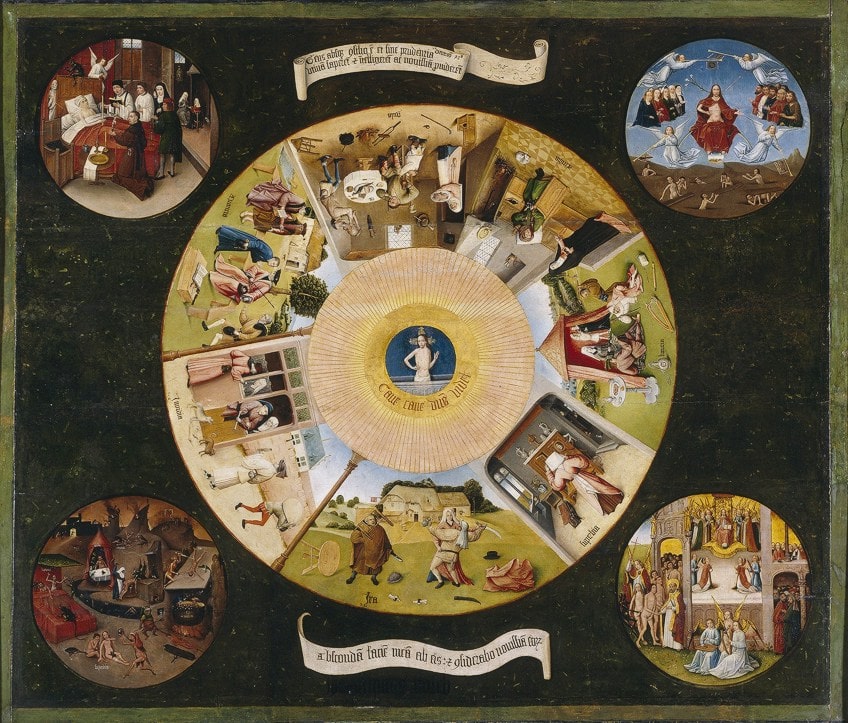
Bosch’s vision was getting more gloriously vast at this point. His forms became leaner, his hues more subdued, and the fantastical worlds he showed combined cataclysmic scenarios with biblical settings of almost bucolic purity.
Later Work
The Garden of Earthly Delights (1490-1510) is without a doubt Bosch’s finest masterwork and most recognizable creation. With his earthly utopia, including the genesis and seduction of woman wonderfully paired with extremely disturbing pictures of the world of hedonism and pleasure-seeking, his aesthetic had attained full development.
The painting’s dreamlike/nightmarish aspect has become folklore, and it has a plethora of miniature nude human beings, malformed animals, and scary monsters supposed to have been generated directly from the artist’s limitless imagination.
The Oxford Dictionary of Art and Artists, on the other hand, states that while works like The Garden of Earthly Delights have “an incredibly vivid imagination and the topics are strongly embellished with divisional tales and emblems and the fundamental motifs are sometimes indeed very straightforward and most of the symbolism can be described in terms of the pop culture of Bosch’s era, noticeably parables and spiritual literature.”

“In strictly visual grounds, the monsters he created have counterparts in the bizarre creatures sometimes found in the borders of ancient manuscripts of medieval art and in the gargoyles of Gothic cathedrals – even the church at s-Hertogenbosch contains some good instances of these gargoyles,” it continues.
Aside from his obsession with the horror and majesty of God’s cosmos, Bosch exhibits a tremendous aptitude for compositional balance and a rigorous eye for details that rivaled that of Renaissance artists.
Indeed, quoting from The Garden of Earthly Delights, the renowned E. H. Gombrich wrote: “For the first, and maybe only time, a medieval artist had managed to give physical and visible form to the horrors that had tormented man’s brains during the Middle Ages. It was an accomplishment that was possibly only achievable at this time when the ancient beliefs were still alive and the contemporary spirit of the Renaissance had equipped the artist with techniques of depicting what he observed “.
Most academics believe The Ship of Fools was written in reaction to Sebastian Brant’s extremely successful satirical work of the same name, which was published in 1494. In his painting Bosch, like Brant, utilized the ship (which is actually a tiny boat) and its guests and hangers-on as a reference for a depraved society in general. The assembly of overjoyed revelers demonstrates Bosch’s link between vice and music once more, however for unknown reasons, the melodic entertainment is supplied here by a priest and a nun.
The ship’s overly long mast is topped by a big branch on which an owl perches, another Boschian image that represents the presence of sin.
Scholars have believed that the “Tree Man” in The Garden of Earthly Delights‘ Hell painting was constructed in the artist’s likeness, but the 1508 self-portrait sketch is the sole documented self-portrait of the painter. It was assumed to have been created eight years before his demise, and it is possible that Bosch “overstated” his age on purpose.
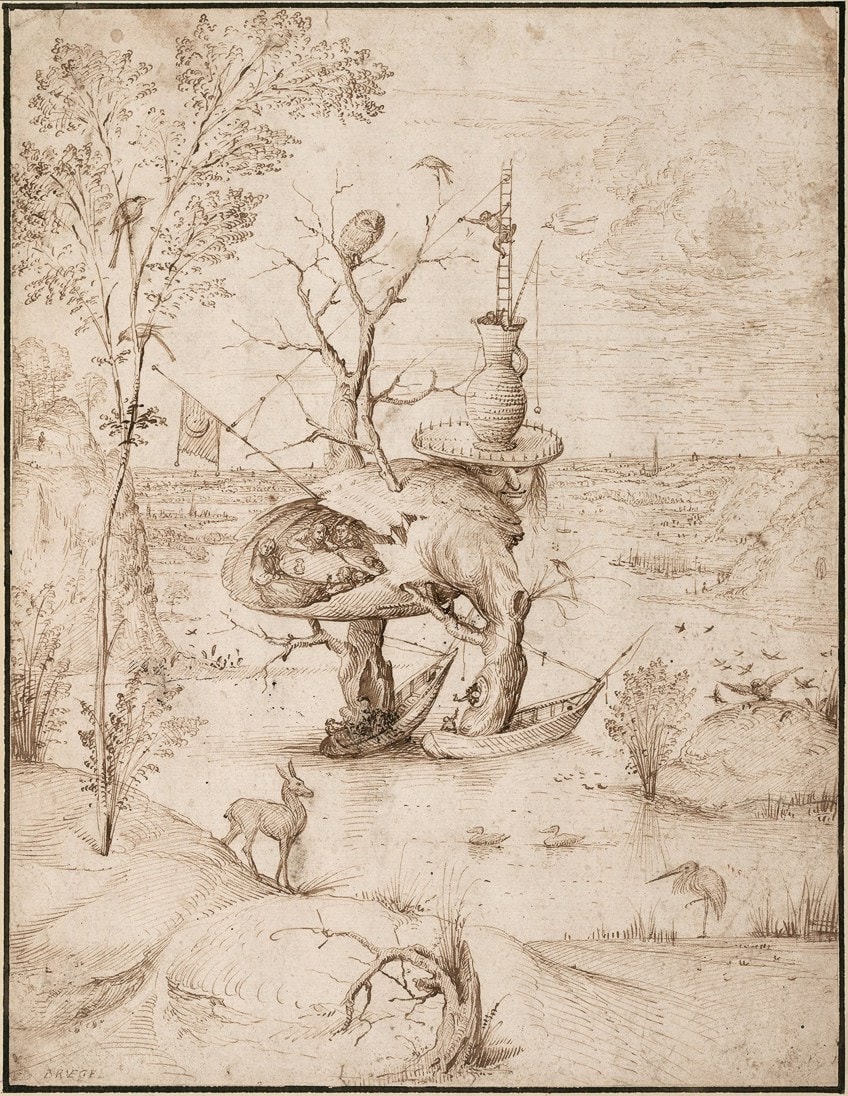
In any event, the sketch appears to presage Bosch’s desire to put a face to his work, maybe in light of the fact that he was nearing the end of his life. Bosch died in 1516, according to the Brotherhood of Our Lady, and a burial ceremony was performed on the 9th of August in the Church of Saint John in s-Hertogenbosch. Despite his indisputable place in art history, Bosch’s output consists of only about 25 paintings and eight sketches. One explanation for this meager return is a moment in the 16th century when Protestant Reformation adherents burned numerous books deemed sinful.
Six of his paintings were purchased or confiscated by Philip II of Spain at the end of the 16th century, while others arose around Europe, leaving a fairly fragmentary and brief history of one of the pantheon’s most unusual painters.
Legacy of Bosch the Artist
During his career, Bosch’s art was acquired in various nations around Europe, and he was highly respected and emulated by pupils and followers, notably Pieter Bruegel the Elder, often known as the “Second Hieronymus,” who was greatly affected by Bosch’s technique of painting landscapes.
Although attention in his works waned (save in Spain), he resurfaced as a modern-era force, influencing the Surrealist movement and artists such as Max Ernst, René Magritte, and notably Salvador Dalí, who believed that Bosch was the very first contemporary artist.
The unique rock structure that resembles Dalí’s face in his renowned painting, The Great Masturbator (1929), was influenced by a similar feature in The Garden of Earthly Delights‘ left panel. Leonora Carrington, who saw Bosch’s paintings in the Museo del Prado in 1939, was also inspired by Bosch’s most renowned composition.

Carrington, for instance, sets hunters in an unsettling scene containing winged creatures and mariners drifting in ocean-like skies that create the setting on which her hooded female giant stands in The Giantess (1947). “It is simple to comprehend why Bosch persists to intrigue us today: the doomsday tonality of his work rang true during our epoch of worldwide conflict and global terrorism,” writes Alastair Sooke.
Indeed, straightforward citations can be discovered in instances from cinema, TV, computer games, novels, and even clothing catalogs.
Tim Smith-Laing adds: “Little, if any, of Hieronymus Bosch’s peers can claim the same level of long-term popularity. He’s a popular attraction at museums, but his influence goes well beyond: adding to the usual books, T-shirts, and cards, he’s received everything from handbags to mousepads and phone covers. Dr. Martens boots with his artwork imprinted on them are also available “.
Hieronymus Bosch’s Art Style and Accomplishments
Bosch was among the first painters to use the triptych as a narrative technique to express abstract notions in his work. Detractors and scholars have discovered a variety of modern topics in his narration, such as environmental, and sociocultural, yet his most recognizable efforts, are most concentrated with symbolism and the overriding theme of humanity’s greatest classic moral conflict between indiscretion and good character.
Many consider him to be the “founder of demons” and a purveyor of visual folly and humor, and his works have proven difficult for critics and historians to decipher.
In reality, Bosch, who was known as “El Bosco” in Spain and was venerated long before the nineteenth-century resurgence of interest in his works, is sometimes alluded to as the “first Surrealist” and was hailed as the original “rediscovery of the subconscious” by the famed psychologist Carl Jung. Unlike other Dutch artists, such as Jan van Eyck, whose brushstrokes are clean and precise, Bosch’s brushstrokes are lively and diverse.

However, his great eye for detail may be credited to his initial studies as a draftsman, which made him one of the first Dutch painters to display drawings as independent (rather than preparatory) works. According to some historians, the idea for the distinctively strange, diabolical entities that haunt his works may be discovered in religious documents from the late medieval art and Renaissance periods.
Indeed, as early as 1605, the Spanish priest José de Sigüenza maintained that his works were “publications of great knowledge and aesthetic worth,” and that if there were “any oddities here, they are for us, not him; they are a painted commentary on the faults and ramblings of mankind.” Bosch primarily painted on oak panels with oil as a medium. Bosch’s palette was fairly limited, including just the standard pigments of the time.
For the blue sky and faraway landscapes, he primarily employed green copper-based glazes, azurites, and paints containing verdigris or malachite ochres, lead-tin-yellow, and red lake for his people.
Interpretations of His Work
When shifting artistic preferences made creatives like Bosch more appealing to the European intellect in the 20th century, sometimes it is contended that Hieronymus Bosch’s hell paintings were inspired by gnostic points of view as well as mysterious hermetic procedures. Again, because Erasmus was trained at one of the Brethren of the Common Life homes in s-Hertogenbosch, and the city was spiritually liberal, some scholars have found it predictable that significant parallels emerge between Erasmus’ scathing writing and Bosch’s frequently forceful painting.

Some, adopting a line of Bosch-interpretation dating back to the 16th century, maintained that his art was produced just to titillate and entertain, similar to the “grotteschi” of the Italian Renaissance. While the work of the earlier masters was focused on the tangible world of everyday life, Bosch presents his audience with “a realm of nightmares in which things seem to flash and shift before our eyes,” in the opinion of Walter Gibson. In one of the first recorded reports of Hieronymus Bosch’s paintings, Felipe de Guevara stated in 1560 that Bosch was only known as “the maker of demons and grotesques.”
Karel van Mander characterized Hieronymus Bosch’s paintings in the early 17th century as “marvelous and odd dreams,” but he determined that the works are “often less delightful than horrible to look at.” Scholars have begun to regard Bosch’s vision as less spectacular in recent decades, accepting that his work represents the traditional religious belief systems of his day.
His representations of sinful mankind, as well as his ideas about Heaven and Hell, are today thought to be compatible with those found in late medieval didactic writing and lectures.
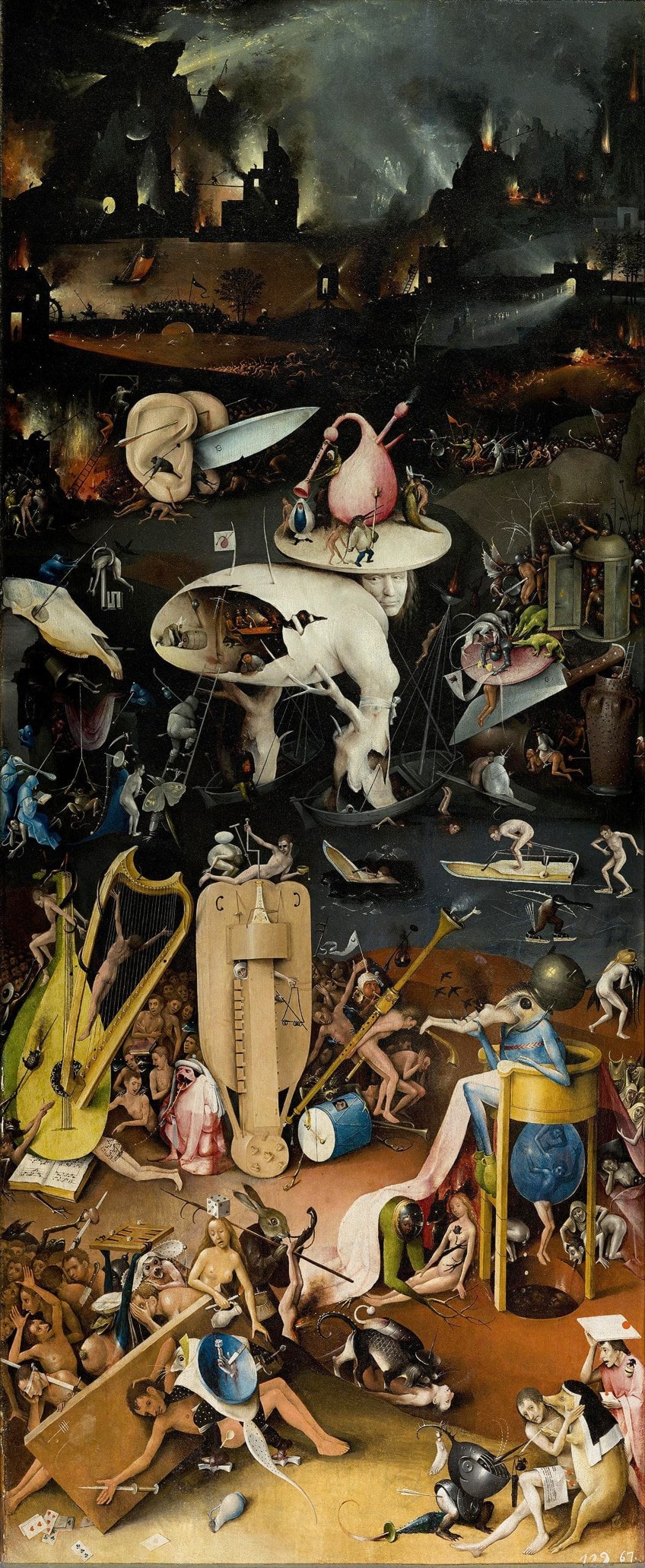
Most authors believe his works have a deeper meaning than previously thought and seek to explain them in terms of late medieval art morality. It is widely assumed that, like other Northern Renaissance luminaries such as poet Robert Henryson, Bosch’s work was meant to teach certain moral and spiritual truths, and that the pictures presented had definite and intentional significance.
Hieronymus Bosch’s paintings, according to Dirk Bax, frequently portray visual translations of linguistic analogies and puns taken from both biblical and mythological sources.
Yet, the dispute of interpretation that his paintings continue to evoke raises fundamental problems regarding the meaning of “uncertainty” in his period’s art. Recent art historians have contributed a new layer to the theme of ambivalence in Bosch’s works, emphasizing sarcastic tendencies, for example, in The Garden of Earthly Delights, both in the middle panel (pleasures) and the right panel (hell).

They hypothesize that irony allows for separation from both the actual world and the depicted dream world, therefore attractive to both liberal and conservative audiences. According to critics, some of the artist’s work has cryptic aspects owing to his unique attention to social, political, and spiritual foes, whose symbolism is by definition ambiguous since it is designed to hide or damage.
According to 2012 research of Bosch’s works, they reveal a strong nationalist conscience, denouncing the foreign imperial rulers of the Burgundian Netherlands, particularly Maximilian Habsburg. According to the research, Bosch created his penance self-punishment by carefully layering pictures and thoughts, because he was taking well-paid contracts from the Habsburgs and their representatives and thereby compromising the legacy of Charles the Bold.
The actual number of remaining works by Bosch has long been a source of contention.

Only seven of his surviving works bear his signature, and it is unknown whether all of the works originally attributed to him were truly created by him. From the early 16th century forward, several copies and adaptations of his works were known to exist. Furthermore, his style was immensely influential, and his countless admirers greatly replicated it.
Historians have ascribed to him fewer and fewer of the masterpieces that were originally supposed to be his.
This is due in part to technological breakthroughs such as laser reflectography, which allows scholars to analyze the underpainting of an artwork. Early and mid-century art historians such as Baldass and Tolnoy identified between 30 and 50 works that they felt were by Bosch’s hand, although a later book by Gerd Unverfehrt (1980) credited just 25 paintings and 14 sketches to him. The Temptation of St. Anthony, long assigned to Hieronymus Bosch’s studio, was attributed to the painter himself in early 2016 following an intense forensic analysis by the Bosch Research and Conservation Project.
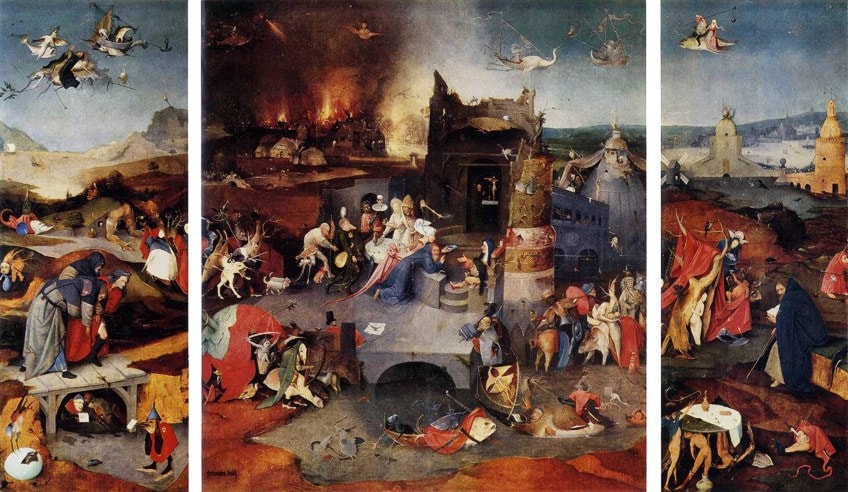
Notable Artworks
Hieronymus Bosch the artist is most immediately associated with paintings that have a shockingly vivid, dream-like look, and he is possibly the most artistically innovative and ethically complex of all Northern European religious artists. Despite the fact that only about 25 original Hieronymus Bosch paintings are believed to exist, the horrible imagery of Hieronymus Bosch’s hell paintings, such as the Garden of Earthly Delights, is instantly identified as “Boschian” and has become a cornerstone of the weird genre.
While his social standing as an iconoclast is undeniable, some historians believe he was a more traditionalist character who, rather than having a distraught psyche, proved equally as capable of being nuanced and supplemented his horrific visuals with fine stylish and spiritual works that encapsulated his deeply held Christian beliefs. Here are a few of his most notable works:
- Extracting the Stone of Madness (c. 1494-1516)
- The Adoration of the Magi (1494)
- The Seven Deadly Sins (1500)
- The Last Judgment (1505)
- The Garden of Earthly Delights (1510)
- The Haywain Triptych (c. 1515)

Recommended Reading
What do you think of this artist’s artwork? Do you want to learn more about his life? Well, then simply go through our list of recommended books to learn more about Bosch the artist.
Hieronymus Bosch: The Complete Works (2021) by Stefan Fischer
Only around 20 paintings and eight sketches are securely credited to Dutch painter Hieronymus Bosch, yet his surreal ideas have established his status as one of history’s most renowned painters. His writings continue to influence researchers, artists, designers, and musicians, as well as death metal band names and designer outfits, 500 years after his death.
This version contains the entire and terrifying Bosch universe in a single compact size.
We examine the artist’s entire scope and captivating innovations, as well as unsettling imagination, through complete spreads and meticulously picked details. We come across his hybrid animals, nightmare scenarios, theological and moral framework, and graphic renditions of modern proverbs and idioms. Along the way, art historian and Bosch specialist Stefan Fischer elucidate the key themes and inspirations in these enigmatic, fascinating works.
- The complete and haunting Bosch world in one compact format
- Exploring the full reach of the artist’s genius and imagination
- Full spreads, carefully curated details, and expert analyses
Hieronymus Bosch (2006) by Larry Silver
Hieronymus Bosch’s phantasmagoric artwork has sparked great attention since the painter’s lifetime, and it is so mysterious that experts have speculated that it holds secret astrological, occult, or even heretical connotations. Nonetheless, none of these hypotheses have ever seemed to give a comprehensive comprehension of Bosch’s work. Furthermore, the artist’s substantial professional success in his home Hertogenbosch, as well as his participation in a conventional religious institution, implies that he pursued his particular creative vision rather than a malevolent ulterior objective.
- An intriguing new monograph by noted art historian Larry Silver
- The first account to include technical investigations of the paintings
- Re-examining the artist's drawings in relation to his paintings
That concludes our look at Hieronymus Bosch’s biography and paintings. Hieronymus Bosch was one of the first painters to employ the triptych as a narrative device in his paintings to portray abstract ideas. Reviewers and academics have found a variety of contemporary motifs in his stories, such as environmental, cultural, and sociopolitical commentary, but his most recognizable works, such as “The Garden of Earthly Delights”, are also most concentrated with religious imagery and the encompassing topic of humanity’s ageless virtuous battle between recklessness and morality.
Frequently Asked Questions
When Was Hieronymus Bosch Born?
Some questions about the artist are hard to get any clear answer to, such as “when was Hieronymus Bosch born?” Unfortunately, not much is known regarding his early life. We do know, however, that he was born around the year 1450.
What Kind of Art Did Bosch the Artist Create?
Hieronymus Bosch’s hell paintings exemplified his style. Bosch’s Garden of Earthly Delights (1490-1510) is without a doubt his most famous and well-known work. His aesthetic had reached complete development with his earthly paradise, which included the origin and seduction of woman, beautifully coupled with profoundly unsettling images of the world of hedonism and pleasure-seeking. The painting’s dreamlike/nightmarish element has established mythology, and it includes a multitude of miniature nudists, misshapen animals, and terrifying creatures that are said to have been created directly from the artist’s infinite imagination.
Isabella studied at the University of Cape Town in South Africa and graduated with a Bachelor of Arts majoring in English Literature & Language and Psychology. Throughout her undergraduate years, she took Art History as an additional subject and absolutely loved it. Building on from her art history knowledge that began in high school, art has always been a particular area of fascination for her. From learning about artworks previously unknown to her, or sharpening her existing understanding of specific works, the ability to continue learning within this interesting sphere excites her greatly.
Her focal points of interest in art history encompass profiling specific artists and art movements, as it is these areas where she is able to really dig deep into the rich narrative of the art world. Additionally, she particularly enjoys exploring the different artistic styles of the 20th century, as well as the important impact that female artists have had on the development of art history.
Learn more about Isabella Meyer and the Art in Context Team.
Cite this Article
Isabella, Meyer, “Hieronymus Bosch – Medieval Art of This Master of Earthly Delights.” Art in Context. January 24, 2022. URL: https://artincontext.org/hieronymus-bosch/
Meyer, I. (2022, 24 January). Hieronymus Bosch – Medieval Art of This Master of Earthly Delights. Art in Context. https://artincontext.org/hieronymus-bosch/
Meyer, Isabella. “Hieronymus Bosch – Medieval Art of This Master of Earthly Delights.” Art in Context, January 24, 2022. https://artincontext.org/hieronymus-bosch/.





